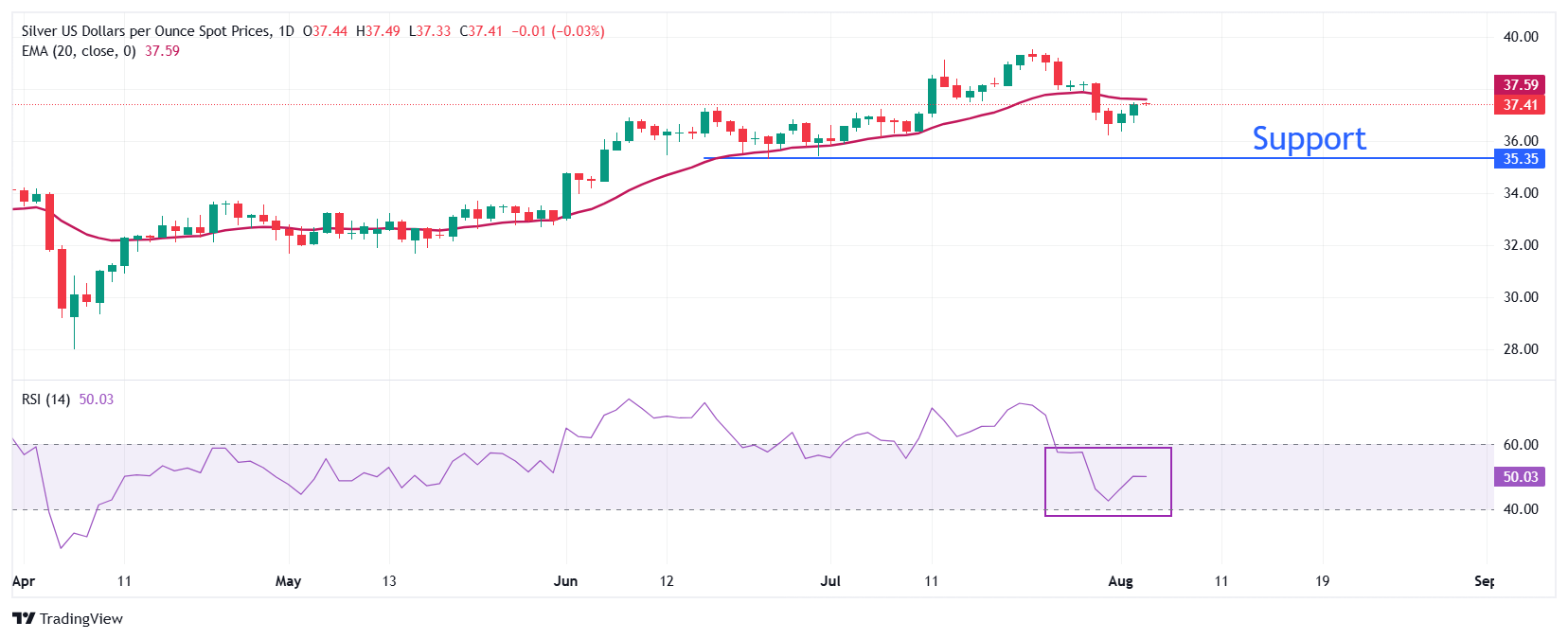Silver Price Forecast: XAG/USD gains further to near $37.50 as Fed rate cut in September looks likely
- Silver price demonstrates strength amid accelerating bets supporting Fed’s interest rate cuts in September.
- Cooling US labor demand has prompted Fed dovish bets.
- Investors await the US Services PMI data for July.
Silver price (XAG/USD) extends its recovery move to near $37.50 during the European trading session on Tuesday. The white metal strengthens as traders have raised bets supporting interest rate cuts by the Federal Reserve (Fed) in the September meeting.
According to the CME FedWatch tool, the probability of the Fed to cut interest rates in the September meeting has increased to 92.2% from 80% seen on Friday, after the release of the United States (US) Nonfarm Payrolls (NFP) data for July, and 41.2% on Thursday.
Theoretically, lower interest rates by the Fed bode well for non-yielding assets, such as Silver.
The US NFP report showed signs of weak labor demand at the time when the global economy is grappling with trade uncertainty due to the introduction of new tariff policy by US President Donald Trump.
The data was in contradiction to Fed Chair Jerome Powell’s commentary that the labor market is broadly stable in the press conference, following the interest rate decision on Wednesday.
Meanwhile, the US Dollar (USD) trades broadly stable ahead of the US revised S&P Global and the ISM Services PMI data for July, which will be published during the North American session. The ISM Services PMI is seen at 51.5, higher from 50.8 in June.
Silver technical analysis
Silver price extends two-day recovery to near the 20-day Exponential Moving Average (EMA) around $37.50 on Tuesday.
The 14-day Relative Strength Index (RSI) oscillates around 50.00, suggesting that the asset lacks momentum.
Looking down, the June 24 low of $35.28 will act as key support for the major. On the upside, the June 30 high near $38.25 will be a critical hurdle for the pair.
Silver daily chart

Silver FAQs
Silver is a precious metal highly traded among investors. It has been historically used as a store of value and a medium of exchange. Although less popular than Gold, traders may turn to Silver to diversify their investment portfolio, for its intrinsic value or as a potential hedge during high-inflation periods. Investors can buy physical Silver, in coins or in bars, or trade it through vehicles such as Exchange Traded Funds, which track its price on international markets.
Silver prices can move due to a wide range of factors. Geopolitical instability or fears of a deep recession can make Silver price escalate due to its safe-haven status, although to a lesser extent than Gold's. As a yieldless asset, Silver tends to rise with lower interest rates. Its moves also depend on how the US Dollar (USD) behaves as the asset is priced in dollars (XAG/USD). A strong Dollar tends to keep the price of Silver at bay, whereas a weaker Dollar is likely to propel prices up. Other factors such as investment demand, mining supply – Silver is much more abundant than Gold – and recycling rates can also affect prices.
Silver is widely used in industry, particularly in sectors such as electronics or solar energy, as it has one of the highest electric conductivity of all metals – more than Copper and Gold. A surge in demand can increase prices, while a decline tends to lower them. Dynamics in the US, Chinese and Indian economies can also contribute to price swings: for the US and particularly China, their big industrial sectors use Silver in various processes; in India, consumers’ demand for the precious metal for jewellery also plays a key role in setting prices.
Silver prices tend to follow Gold's moves. When Gold prices rise, Silver typically follows suit, as their status as safe-haven assets is similar. The Gold/Silver ratio, which shows the number of ounces of Silver needed to equal the value of one ounce of Gold, may help to determine the relative valuation between both metals. Some investors may consider a high ratio as an indicator that Silver is undervalued, or Gold is overvalued. On the contrary, a low ratio might suggest that Gold is undervalued relative to Silver.






